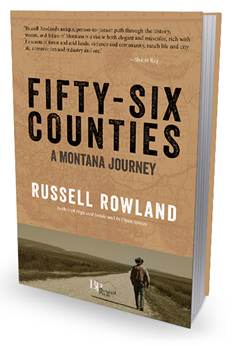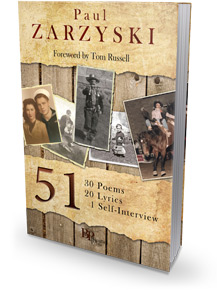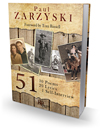
Montana has a long and celebrated tradition of artful, reflective nonfiction. From Joseph Kinsey Howard’s Montana: High, Wide, and Handsome to K. Ross Toole’s Montana: An Uncommon Land, and our own Montana: Then and Now by Aaron Parrett, we’ve been gifted with a series of erudite and sharp-eyed guides to help us see who we are. To this eminent list we can now add Russell Rowland’s Fifty-Six Counties: A Montana Journey.
A native Montanan and an applauded novelist (In Open Spaces, High and Inside), Rowland spent the better part of a year studying and traveling around his beloved home state, from the mines of Butte to the pine forests of the Northwest, from the stark, wind-scrubbed badlands of the East to the tourist-driven economies of the West. Along the way, he considered our state’s essential character, where we came from, and, most of all, what we might be in the process of becoming.
Click here to download an excerpt >>
Book Information
Dimensions: 6 x 9
Price: $22.95 Paperback, $9.99 Ebook
Release Date to Independent Bookstores: April 15, 2016
General Release Date: June 1, 2016
About Russell Rowland
 Russell Rowland is the highly-applauded author of three novels set in Montana— High and Inside, In Open Spaces, and The Watershed Years—as well as co-editor of an anthology, West of 98: Living and Writing the New American West. He lives in Billings, Montana.
Russell Rowland is the highly-applauded author of three novels set in Montana— High and Inside, In Open Spaces, and The Watershed Years—as well as co-editor of an anthology, West of 98: Living and Writing the New American West. He lives in Billings, Montana.
Praise for Fifty-Six Counties
“Fifty-Six Counties: A Montana Journey is astounding in beauty and vitality, interwoven with great wisdoms about human shadow and human light, touched by divine notions of the sacredness that binds all people, and graced with a hard won and ultimately natural sense of illumination.”
— Shann Ray, author of American Copper, winner of the Spur Award
“In a voice all his own, Rowland proves to be warm and personable, and yet cutting and real—basically, one couldn’t wish for a better guide to the state of Montana. This book is utterly unique. A gorgeous accomplishment.”
— Laura Pritchett, author of Stars Go Blue, winner of the High Plains Book Award
“Fifty-Six Counties is a remarkable book: a macro-focused narrative using a wide-angle lens. If you have room for only one book about Montana on your shelf, make it this one.
— David Abrams, author of Fobbit
Praise for Russell Rowland
“Russell Rowland has given us a vivid and distinctive piece of homespun to take its proper place in the literary quilt of the West.”
— Ivan Doig
“Charged with dramatic tension—a joy to read.”
— Ha Jin
“Russell Rowland’s compelling Montanans show us the extraordinary that lurks in ordinary lives, reveal the epic heart of everyday trials and triumphs.”
— Guy Vanderhaeghe
“[An] outstanding debut.”
— Publishers Weekly (starred review)
“A gracefully understated novel.”
— New York Times Book Review
“You simply can’t move your eyes from the page.”
— Mark Smirnoff, The New York Times Book Review
“[An] unpretentious, involving story told with unfaltering authority.”
— Kirkus Reviews
“As a lifelong reader of books written about the West, particularly those about Montana, Russell Rowland’s In Open Spaces is as good as it gets…a powerful book.”
— C. J. Box
“Rowland’s people are on a search, and he writes them with wit, humility, and a satisfying sense of trajectory.”
— Leif Enger
“A raucous tragicomedy, infused with the desire we all feel in the face of our greatest mistakes: to somehow win redemption, no matter how large our flaws.”
— Kim Barnes
“At times funny, at times tragic, often wise and always moving, this wonderful novel is a grand slam of indelible characters and infectious drama, and a flat-out great read.”
— Alan Heathcock
Excerpt
Chapter One: The First Signs of Chaos
The job of rewriting our past started from the beginning, with the first book ever published in Montana, The Vigilantes of Montana. Thomas Dimsdale, who was the editor of the Montana Post in Virginia City, wrote this book just after some very interesting events unfolded around him, and the book reads that way, like an article from the local sports page, as if Dimsdale was celebrating the heroic feats of the high school football team.
Although much has been written about this period, my own personal favorite being A Good Orderly Lynching by Frederick Allen, the importance of these events and the way they were reported cannot be overstated. Dimsdale was a colorful writer, and by all accounts a fine reporter, but he also had to live in the same community as the vigilantes, during a time when everyone was walking those dusty streets in complete fear. Between the Native Americans and the road agents that finally inspired the vigilantes to action, and finally with the vigilantes themselves, people never knew when they might be attacked, pulled aside and questioned, beaten, or strung from a tree.
Dimsdale seems to have been convinced that he was reporting the events in an unbiased manner, but he had little chance of not being biased toward the vigilantes because, when it came right down to it, his life depended on it. Those who spoke out against them—and that included two of the most prominent lawyers in the region, James Thurmond and H.P.A Smith—often found themselves chased out of town by threats of death. A few years after being exiled, Thurmond would file a defamation suit against one of the founders of the Vigilante Committee, and would win a settlement of eight thousand dollars in a Utah court. These guys didn’t like anyone pointing out when they were in the wrong, and they were often in the wrong. Toward the end of their reign, a man was hung just for expressing his disapproval of their activities. And they continued to act despite direct orders from federal judges to cease and desist.
Today, at first glance, it is impossible to imagine that the sixty-mile stretch between Bannack and Virginia City could inspire the kind of greed that led to dozens of men being hung. There is nothing the least bit remarkable about the area where Bannack sits now which no doubt explains why nobody lives there anymore. But for several years this area was the number one destination for people moving West. It’s even harder to imagine when you consider that most of these pioneers traveled thousands of miles, mostly by horse and wagon, and often on foot. Before there were actual roads.
















